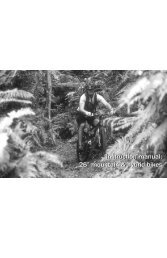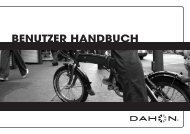BRUKERVEILEDNING - Dahon
BRUKERVEILEDNING - Dahon
BRUKERVEILEDNING - Dahon
Create successful ePaper yourself
Turn your PDF publications into a flip-book with our unique Google optimized e-Paper software.
Riding Safety<br />
Safety<br />
• You are sharing the road or the path with<br />
•<br />
•<br />
Never hitch a ride by holding on to another<br />
vehicle.<br />
Don’t weave through traffic or make unexothers<br />
— motorists, pedestrians and other pected moves.<br />
The Basics<br />
•<br />
cyclists. Respect their rights.<br />
Ride defensively. Always assume that others<br />
•<br />
•<br />
Observe and yield the right of way.<br />
Never ride your bicycle while under the influ-<br />
WARNING: It is your responsibility to<br />
familiarize yourself with the laws<br />
where you ride and to comply with all<br />
•<br />
do not see you.<br />
Look ahead, and be ready to avoid:<br />
» Vehicles slowing or turning, entering the<br />
•<br />
ence of alcohol or drugs.<br />
If possible, avoid riding in bad weather,<br />
when visibility is obscured, at dawn, dusk or<br />
applicable laws, including properly<br />
equipping yourself and your bike as the law<br />
requires.<br />
»<br />
road or your lane ahead of you, or coming<br />
up behind you.<br />
Parked car doors opening.<br />
in the dark, or when extremely tired. Each<br />
of these conditions increases the risk of<br />
accident.<br />
Observe all local bicycle laws and regulations.<br />
» Pedestrians stepping out.<br />
Observe regulations about bicycle lighting,<br />
licensing of bicycles, riding on sidewalks, laws<br />
»<br />
»<br />
Children or pets playing near the road.<br />
Potholes, sewer grating, railroad tracks, Wet Weather Riding<br />
regulating bike path and trail use, helmet laws,<br />
child carrier laws, and special bicycle traffic<br />
laws. It’s your responsibility to know and obey<br />
your country’s laws.<br />
• Always do check the safety of your bike<br />
before you ride it.<br />
• Be thoroughly familiar with the controls of<br />
your bicycle: brakes (Section 4.B); pedals<br />
(Section G); shifting (Section 4.C).<br />
• Be careful to keep body parts and other<br />
objects away from the sharp teeth of chain<br />
rings, the moving chain, the turning pedals<br />
and cranks, and the spinning wheels of your<br />
bicycle.<br />
•<br />
•<br />
•<br />
•<br />
expansion joints, road or sidewalk construction,<br />
debris and other.<br />
» The many other hazards and distractions<br />
which can occur on a bicycle ride.<br />
Ride in designated bike lanes, on designated<br />
bike paths or as close to the edge of<br />
the road as possible, in the direction of the<br />
traffic flow or as directed by local governing<br />
laws.<br />
Stop at stop signs and traffic lights; slow<br />
down and look both ways at street intersections.<br />
Remember that a bicycle always loses<br />
in a collision with a motor vehicle.<br />
Use approved hand signals for turning and<br />
stopping.<br />
Never ride with headphones.<br />
WARNING: Wet weather impairs<br />
traction, braking and visibility, both<br />
for the bicyclist and for other vehicles<br />
sharing the road. The risk of an accident is<br />
dramatically increased in wet conditions.<br />
Under wet conditions, the stopping power of<br />
your brakes (as well as the brakes of other vehicles<br />
sharing the road) is dramatically reduced<br />
and your tires don’t grip nearly as well. This<br />
makes it harder to control speed and easier to<br />
lose control. To make sure that you can slow<br />
down and stop safely in wet conditions, ride<br />
more slowly and apply your brakes earlier and<br />
more gradually than you would under normal,<br />
dry conditions. See also Section 4.B.<br />
• Never carry a passenger.<br />
33<br />
EN





